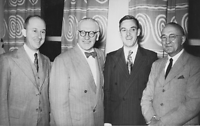


Developing dental education and research in Victoria
Introduction
Participants
Building a dental research culture
The influence of Frank Wilkinson
Developing linkages between the Dental School and Dental Hospital
The art and science of dentistry
The introduction and impact of fluoridation
Resolving a long-standing dispute with dental technicians
Training of dental health therapists
Dentistry's relationship with hospitals, government and industry
Controversy over the Dental School quota
The relationship between the School and the University of Melbourne
Relations between the School and the Australian Dental Association
The role of the School in childhood dental health
Funding research through the CRC and other programs
Personalities
Appendix; Some further thoughts stimulated by the Witness seminar
Endnotes
Index
Search
Help
Contact us

Peter Reade: When I arrived in 1968, I was given the job of writing the report of the Ministerial Inquiry into the Dental Hospital [and the Dental School],[48] something I had no part in. I think that [Inquiry] was the outcome of this disturbance over the years between various factions having problems.
Henry Atkinson: The fuse [for the Health Minister establishing the inquiry in early 1965] was that the College [of Dentistry, which ceased to exist as an educational body in 1963 and was formally deregistered in 1967][49] was trying to increase the number of students beyond the capacity of the staff, which hadn’t increased. We decided that as soon as we possibly could, we’d try to decrease the quota. In 1963, with Tony’s backup – I was Dean – we got the quota down from 73 to 45. You can imagine what that did, politically!
Pat Storey: Across the University, post-war, there was a huge influx of students but no increase of staff to teach them and everyone was really pressed at that time.
Henry Atkinson: We were the worst off because the College had a philosophy that if we asked for staff before the [new Hospital and School] building was completed, the government wouldn’t complete the building. So we had to save our requests until after the building was completed.
John Hales: Could I ask John Harcourt the role of the Journal in encouraging and publishing research papers. Was this part of your role?
John Harcourt: Dr Bill Tuckfield was Editor of the Australian Journal of Dentistry almost continuously from about 1914 until the Australian Dental Journal came out in 1956. In that time, there were certainly a number of research papers that came out of Melbourne.

By 1985 (when I became Editor of the ADJ), we had a selection of research papers. But people found our publishing rate was too slow. That’s why a number of overseas papers were published, for which I was roundly criticised in some quarters.
Peter Reade: I’d like to return to the Ministerial Inquiry to which I referred earlier and what it led to, because I think that’s quite important. I think it led to the Hospital and the Dental School becoming a lot more closely linked.
To help with staffing [of the School], the staff members of the Hospital were required as part of their jobs to participate in teaching which was quite a dramatic change as I understood it as ‘the new boy’.
As well, the School was represented on Hospital selection committees, and vice-versa. And for the next 20 or 30 years, a very close working relationship developed. The reliance [of the School] on the Hospital to provide teachers, and [of the Hospital] on the University to provide specialist clinical staff is a situation that doesn’t exist at present.
Henry Atkinson: It went even further than that. Dr Lindell, the Chairman of the Hospitals and Charities Commission [and a member of the Committee of Inquiry], moved strongly to get the Dental Hospital into the same position as the University medical teaching hospitals, particularly along the lines of the Austin Hospital. We were within a hair’s breath of achieving that but, unfortunately, the Hospital wavered, and Sir Arthur [Amies] voted against it so we didn’t make the grade. Nonetheless there was a very great improvement.
Tony [Storey] did a very good thing later on in that, in spite of the fact that we were not a teaching hospital, he established a Clinical School and a Clinical Dean which brought the two groups even closer together. But it seems to have faded a little.
The art and science of dentistry
Pat Storey: People in private practice earned a great deal more than people in the Dental School and one was slightly looked down on if one was willing to accept such a cut in income. They assumed that you couldn’t make a go of it in private practice and were a bit of a failure if you went to the Dental School, which came to be regarded as a sort of net to catch incompetent dentists.
In those days, too, as in medicine, a lot of the teaching relied on honorary staff coming up from Collins St to teach the students. They seemed to think that they knew how to run Dental Schools and students, and there was a constant barrage of advice.
John Harcourt: All those incompetent people were responsible for training the next generation of dentists! I think they were mostly reasonably competent.
 |
Witness to the History of Australian Medicine |  |
© The University of Melbourne 2005-16
Published by eScholarship Research Centre, using the Web Academic Resource Publisher
http://witness.esrc.unimelb.edu.au/100.html